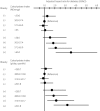Dietary carbohydrate intake, presence of obesity and the incident risk of type 2 diabetes in Japanese men
- PMID: 27330720
- PMCID: PMC4847888
- DOI: 10.1111/jdi.12433
Dietary carbohydrate intake, presence of obesity and the incident risk of type 2 diabetes in Japanese men
Abstract
Aims/introduction: The present cohort study assessed the risk among Japanese men for developing type 2 diabetes, based on the percentage of energy intake from carbohydrates and degree of obesity.
Participants and methods: The participants were 2,006 male factory employees, and the macronutrient intake of each patient was measured using a self-administered diet history questionnaire. The incidence of diabetes was determined in annual blood examinations over a 10-year period.
Results: During the study, 232 participants developed diabetes. The crude incidence rates (/1,000 person-years) for different levels of carbohydrate intake as a percentage of calories consumed (<50.0, 50.0-57.4, 57.5-65.0, >65.0% of energy intake) were 16.5, 14.4, 12.7 and 17.6. Overall, carbohydrate intake was not associated with the risk of diabetes. However, there was significant interaction between carbohydrate intake and degree of obesity on the incidence of diabetes (P for interaction = 0.024). Higher carbohydrate intake was associated with elevated risk for diabetes among participants with a body mass index ≥25.0 kg/m(2) (P for trend = 0.034). For obese participants, the multivariate-adjusted hazard ratio for those with carbohydrate intakes >65% energy was 2.01 (95% confidence interval 1.08-3.71), which was significantly higher than that of participants with carbohydrate intakes 50.0-57.4% energy.
Conclusions: Higher carbohydrate intake was associated with higher risk of diabetes in obese participants, but not in non-obese participants. Obese participants with carbohydrate intakes >65% energy should reduce their intakes to levels within the desirable carbohydrate energy proportion for Japanese (50-65% energy) to prevent development of type 2 diabetes.
Keywords: Cohort study; Dietary carbohydrates; Incidence.
Figures

Similar articles
-
Sex-specific interactions between the IRS1 polymorphism and intakes of carbohydrates and fat on incident type 2 diabetes.Am J Clin Nutr. 2013 Jan;97(1):208-16. doi: 10.3945/ajcn.112.046474. Epub 2012 Dec 5. Am J Clin Nutr. 2013. PMID: 23221578
-
Differences in food intake among obese and nonobese women and men with type 2 diabetes.J Am Coll Nutr. 2011 Aug;30(4):225-32. doi: 10.1080/07315724.2011.10719964. J Am Coll Nutr. 2011. PMID: 21917702
-
Dietary Carbohydrate and Fat Intakes and Risk of Mortality in the Japanese Population: the Japan Multi-Institutional Collaborative Cohort Study.J Nutr. 2023 Aug;153(8):2352-2368. doi: 10.1016/j.tjnut.2023.05.027. Epub 2023 Jun 2. J Nutr. 2023. PMID: 37271417
-
Genetic variation in the glucose-dependent insulinotropic polypeptide receptor modifies the association between carbohydrate and fat intake and risk of type 2 diabetes in the Malmo Diet and Cancer cohort.J Clin Endocrinol Metab. 2012 May;97(5):E810-8. doi: 10.1210/jc.2011-2444. Epub 2012 Mar 7. J Clin Endocrinol Metab. 2012. PMID: 22399504
-
Moderating "the great debate": The carbohydrate-insulin vs. the energy balance models of obesity.Cell Metab. 2023 May 2;35(5):737-741. doi: 10.1016/j.cmet.2023.03.020. Epub 2023 Apr 21. Cell Metab. 2023. PMID: 37086719 Review.
Cited by
-
Association between dietary carbohydrate intake and risk of type 2 diabetes: a systematic review and meta-analysis of cohort studies.Diabetol Int. 2023 Jul 4;14(4):327-338. doi: 10.1007/s13340-023-00642-0. eCollection 2023 Oct. Diabetol Int. 2023. PMID: 37781458 Free PMC article. Review.
-
Dietary Principles, Interventions and Oxidative Stress in Psoriasis Management: Current and Future Perspectives.Medicina (Kaunas). 2025 Jul 18;61(7):1296. doi: 10.3390/medicina61071296. Medicina (Kaunas). 2025. PMID: 40731925 Free PMC article. Review.
-
The Influence of Prenatal Exercise on Offspring Health: A Review.Clin Med Insights Womens Health. 2016 Oct 17;9:37-42. doi: 10.4137/CMWH.S34670. eCollection 2016. Clin Med Insights Womens Health. 2016. PMID: 27777506 Free PMC article. Review.
-
White common bean extract remodels the gut microbiota and ameliorates type 2 diabetes and its complications: A randomized double-blinded placebo-controlled trial.Front Endocrinol (Lausanne). 2022 Oct 11;13:999715. doi: 10.3389/fendo.2022.999715. eCollection 2022. Front Endocrinol (Lausanne). 2022. PMID: 36303868 Free PMC article. Clinical Trial.
-
Novel Insights into the Pathogenesis and Management of the Metabolic Syndrome.Pediatr Gastroenterol Hepatol Nutr. 2020 May;23(3):189-230. doi: 10.5223/pghn.2020.23.3.189. Epub 2020 May 8. Pediatr Gastroenterol Hepatol Nutr. 2020. PMID: 32483543 Free PMC article. Review.
References
-
- Yoon KH, Lee JH, Kim JW, et al Epidemic obesity and type 2 diabetes in Asia. Lancet 2006; 368: 1681–1688. - PubMed
-
- Park YW, Allison DB, Heymsfield SB, et al Larger amounts of visceral adipose tissue in Asian Americans. Obes Res 2001; 9: 381–387. - PubMed
-
- He Q, Horlick M, Thornton J, et al Sex and race differences in fat distribution among Asian, African‐American, and Caucasian prepubertal children. J Clin Endocrinol Metab 2002; 87: 2164–2170. - PubMed
-
- Chen KW, Boyko EJ, Bergstrom RW, et al Earlier appearance of impaired insulin secretion than of visceral adiposity in the pathogenesis of NIDDM. 5‐Year follow‐up of initially nondiabetic Japanese‐American men. Diabetes Care 1995; 18: 747–753. - PubMed
-
- Matsumoto K, Miyake S, Yano M, et al Glucose tolerance, insulin secretion, and insulin sensitivity in nonobese and obese Japanese subjects. Diabetes Care 1997; 20: 1562–1568. - PubMed
MeSH terms
Substances
LinkOut - more resources
Full Text Sources
Other Literature Sources
Medical

